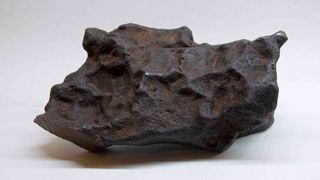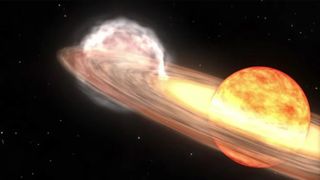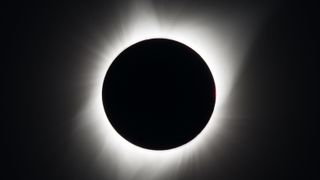Space.com contributing writer Stefanie Waldek is a self-taught space nerd and aviation geek who is passionate about all things spaceflight and astronomy. With a background in travel and design journalism, as well as a Bachelor of Arts degree from New York University, she specializes in the budding space tourism industry and Earth-based astrotourism. In her free time, you can find her watching rocket launches or looking up at the stars, wondering what is out there. Learn more about her work at www.stefaniewaldek.com.
Latest articles by Stefanie Waldek

The James Webb Space Telescope is studying an exoplanet's eternal day — and eternal night
By Stefanie Waldek published
A tidally locked gas giant experiences eternal sunshine on one side, and eternal darkness on the other.

Newly discovered cave on the moon could house future lunar astronauts
By Stefanie Waldek published
The lava tube is likely one of many on the lunar surface.

Drone racing is helping train AI to autonomously drive spacecraft
By Stefanie Waldek published
ESA and the Delft University of Technology are training neural-network AI systems to race drones in preparation for complicated spacecraft maneuvers.

Europe's Mars sample return orbiter moving ahead despite NASA budget uncertainty
By Stefanie Waldek published
The European Space Agency's Earth Return Orbiter has passed its design review, which validates its technical details and moves the project onto manufacturing and testing.

The early solar system was donut-shaped, meteorite study suggests
By Stefanie Waldek published
Researchers studying iron meteorites suggest that the early solar system took the shape of a donut, not a dartboard as previously thought.

Once-in-a-lifetime star explosion, visible from Earth, could happen any day now
By Stefanie Waldek published
Binary star system T Coronae Borealis (T CrB) is about to go nova any day now. The recurrent nova explodes approximately every 79 or 80 years.

NASA's Juno probe reveals lava lakes across Jupiter's volcanic moon Io (image)
By Stefanie Waldek published
Infrared images showcase "fire-breathing" lakes all across the Jovian moon.

James Webb Space Telescope spies never-before-seen star behavior in distant nebula (video, photo)
By Stefanie Waldek published
A new James Webb Space Telescope image shows perfectly aligned protostellar outflows in the Serpens Nebula, supporting a long-running theory of stellar formation.

Is Jupiter's Great Red Spot an impostor? Giant storm may not be the original one discovered 350 years ago
By Stefanie Waldek published
Astronomer Giovanni Cassini observed Jupiter's 'Permanent Spot' in 1665, but new research suggests it's a different vortex from today's Great Red Spot.

Could nearby stars have habitable exoplanets? NASA's Chandra X-ray Observatory hopes to find out
By Stefanie Waldek published
Astronomers are using the Chandra X-ray Observatory to study stars' radiation and establish the feasibility of exoplanet habitability.

Voyager 1 is back online! NASA's most distant spacecraft returns data from all 4 instruments
By Stefanie Waldek published
Following a technical error in November 2023, NASA's deep-space explorer has resumed full science operations.

Bark! Meow! Cluck! NASA uses lasers to beam pictures of pet dogs, cats and chickens to the ISS
By Stefanie Waldek published
NASA is testing how infrared light can transfer far more information than radio frequency communications.

Mars meteorites reveal clues about what lies within the Red Planet
By Stefanie Waldek published
Volcanic meteorites from Mars give scientists a glimpse into the planet's structure.

Jupiter's raging gas cyclones may actually mirror Earth's oceans. Here's how
By Stefanie Waldek published
Jupiter and Earth's oceans have more in common than you might think.

Satellite data reveals Antarctica's Thwaites Glacier is melting faster than we thought
By Stefanie Waldek published
The ICEYE satellite constellation has given researchers a peek beneath the glacier, and it's not looking good.

Solar storm frenzy of May 2024 was strong enough to affect the deep sea
By Stefanie Waldek published
Ocean Networks Canada's (ONC) deep-sea observatories recorded disturbances in the Earth's magnetic field.

India's space agency has been carefully watching our sun's solar tantrums
By Stefanie Waldek published
The Indian Space Research Organization has released solar storm data from ground stations and spacecraft, including the Chandrayaan-2 lunar orbiter.

To better predict volcanic eruptions, you have to dig deep — very deep
By Stefanie Waldek published
New research suggests studying the state of magma in deep reservoirs can improve volcanic eruption predictions.

See this galaxy's bright center? It's home to a voracious supermassive black hole
By Stefanie Waldek published
To launch Black Hole Week, NASA released this new Hubble image of spiral galaxy NGC 4951.

A Switzerland-size hole opened in Antarctica's sea ice in 2016-17. Now we know why
By Stefanie Waldek published
During the winters of 2016 and 2017, a hole the size of Switzerland opened in the middle of Antarctica's sea ice. And scientists just figured out how it came to be.

This spacecraft is headed to NASA's asteroid-crash aftermath — but first, it'll stop by Mars
By Stefanie Waldek published
During a gravity assist with Mars, Hera will study the moon Deimos.

Private moon lander will carry Nokia's 4G cell network to the lunar surface this year
By Stefanie Waldek published
Nokia is developing a LTE/4G communications system for the moon, and its first piece of the network might launch as soon as late this year.

Watch 2 gorgeous supernova remnants evolve over 20 years (timelapse video)
By Stefanie Waldek published
These supernova remnants are moving at extraordinary speeds only visible to us in long-term timelapses.
Breaking space news, the latest updates on rocket launches, skywatching events and more!



